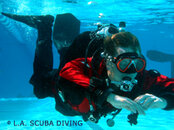Hello all:
I purchased a HOG BP/W from Jim and finally got my first couple dives in this weekend. While I really enjoyed the fit, there were some "operational" issues that I was looking for some help:
My Setup:
I historically dive dry in Puget Sound, and when I was using the shops rental AquaLung BCD, my logs show I was wearing 24 lbs of weight on a weight belt and also had 2 ankle weights (not included in total weight).
This dive had the BP/W with 2-4# weights attached to lower cam bands and 2-4# weights attached to waist belt. Also had ankle weights. This would mean I was weighted to 22lbs (minus ankles) vs 24 lbs. I went 2# less given no buoyancy of BP/W vs BCD.
OK, now my issues:
1) i needed 4 lbs weight in addition to the 22# i started with to bring me up to a total of 26 lbs. I had hoped to get by with a little less weight. My body weight has actually dropped by 10# from the last time I dove dry but otherwise all other equipment was identical. I'm trying to figure out why I needed more weight to be neutral at 15 feet. Thoughts??
2) Rotation of rig. What was most disturbing, but not scary, was the amount of roll while underwater. It seemed every move of my body right to left or left to right would cause me to want to "turtle" and turn face up. I never actually rolled, but sure would have if I let it. I tried using the wing primarily for buoyancy on first dive, then tried using dry suit primarily for buoyancy on the second dive. No discernible effect on this roll. I did get pretty good at a swift move of the hips to counter this roll effect though.
Having read through hundreds if not thousands of posts on BP/W before I made the leap, I never saw this come up. So, here I am. Any thoughts on a cause and more importantly a solution. Should I move all my weight to my front?
Thanks in advance for any help or suggestions
I purchased a HOG BP/W from Jim and finally got my first couple dives in this weekend. While I really enjoyed the fit, there were some "operational" issues that I was looking for some help:
My Setup:
I historically dive dry in Puget Sound, and when I was using the shops rental AquaLung BCD, my logs show I was wearing 24 lbs of weight on a weight belt and also had 2 ankle weights (not included in total weight).
This dive had the BP/W with 2-4# weights attached to lower cam bands and 2-4# weights attached to waist belt. Also had ankle weights. This would mean I was weighted to 22lbs (minus ankles) vs 24 lbs. I went 2# less given no buoyancy of BP/W vs BCD.
OK, now my issues:
1) i needed 4 lbs weight in addition to the 22# i started with to bring me up to a total of 26 lbs. I had hoped to get by with a little less weight. My body weight has actually dropped by 10# from the last time I dove dry but otherwise all other equipment was identical. I'm trying to figure out why I needed more weight to be neutral at 15 feet. Thoughts??
2) Rotation of rig. What was most disturbing, but not scary, was the amount of roll while underwater. It seemed every move of my body right to left or left to right would cause me to want to "turtle" and turn face up. I never actually rolled, but sure would have if I let it. I tried using the wing primarily for buoyancy on first dive, then tried using dry suit primarily for buoyancy on the second dive. No discernible effect on this roll. I did get pretty good at a swift move of the hips to counter this roll effect though.
Having read through hundreds if not thousands of posts on BP/W before I made the leap, I never saw this come up. So, here I am. Any thoughts on a cause and more importantly a solution. Should I move all my weight to my front?
Thanks in advance for any help or suggestions





